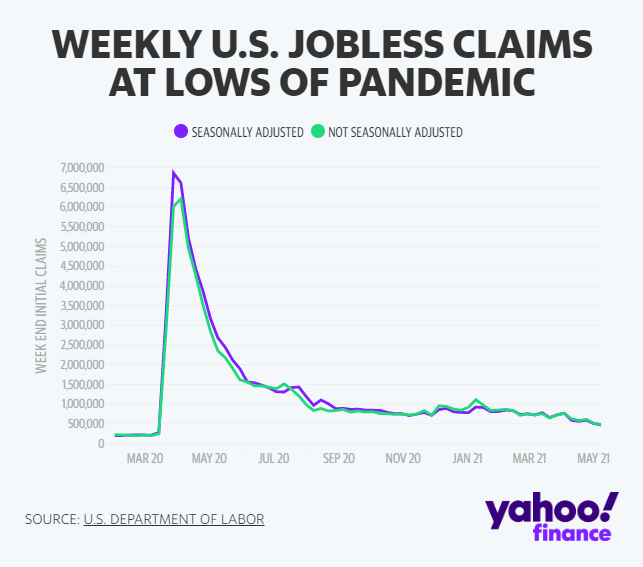Initial unemployment claims dropped more than expected to a fresh pandemic-era low, with new filings inching back toward pre-pandemic levels as more vaccinated Americans return to work and in-person activities.
TheDepartment of Labor released its weekly reporton new jobless claims Thursday at 8:30 a.m. ET. Here were the main metrics expected from the report, compared to consensus data compiled by Bloomberg:
Initial jobless claims, week ended May 8:473,000 vs. 490,000 expected and an upwardly revised 507,000 during prior week
Continuing claims, week ended May 1:3.655 million vs. 3.650 million expected and an upwardly revised 3.700 million during prior week
Weekly jobless claims have nearly halved since the start of 2021, and have fallen precipitously from their pandemic-era high of more than 6 million last year. The last several months' worth of marked improvements coincided with a fast-ramping vaccination program in the U.S., and widespread easing of social distancing restrictions across many states. Prior to the pandemic, new jobless claims averaged just over 200,000 per week throughout 2019.
Initial claims "are moving in the right direction," Rubeela Farooqi, chief U.S. economist for High Frequency Economics, wrote in a note on Tuesday. "The labor market is healing, and layoffs should ease further as the economy moves closer towards normal capacity."
But improvements in the Labor Department's weekly jobless claims figures belie some ongoing strain in the labor market, even as more businesses reopen.Friday's jobs report showed a sharply disappointing 266,000 jobs returned in April,for a print well below the 1 million payroll additions expected. And the economy remains more than 8 million jobs short of pre-pandemic levels, the data showed.
Many businesses have now cited labor supply constraints, rather than a lack of demand for employees, as the key concern.A report earlier this week showed that job openingsin the U.S. hit a record high of more than 8 million in March, far exceeding expectations. Some economists have pointed to enhanced unemployment benefits as a factor contributing to these shortages, especially in the service sector, as federal COVID-era jobless benefits make staying on the sidelines of the workforce a competitive alternative to working a lower-wage job.
"Labor supply appears to be tighter than the unemployment rate suggests, likely reflecting the impact of unusually generous unemployment benefits and lingering virus-related impediments to working,"Goldman Sachs chief economist Jan Hatzius said in a note this week about the April jobs report. He added, however, that "it is hard to know how exactly much of the miss these factors account for."
Headline new claims aside, the Labor Department's weekly reports continue to show that an elevated, albeit improving, number of Americans are still unemployed. More than 16.8 million Americans were still receiving unemployment benefits across all programs during the week ended April 24, for an increase of nearly 700,000 compared to the prior week. That included more than 12 million Americans on the federal Pandemic Unemployment Assistance and Pandemic Emergency Unemployment Compensation programs.

精彩评论